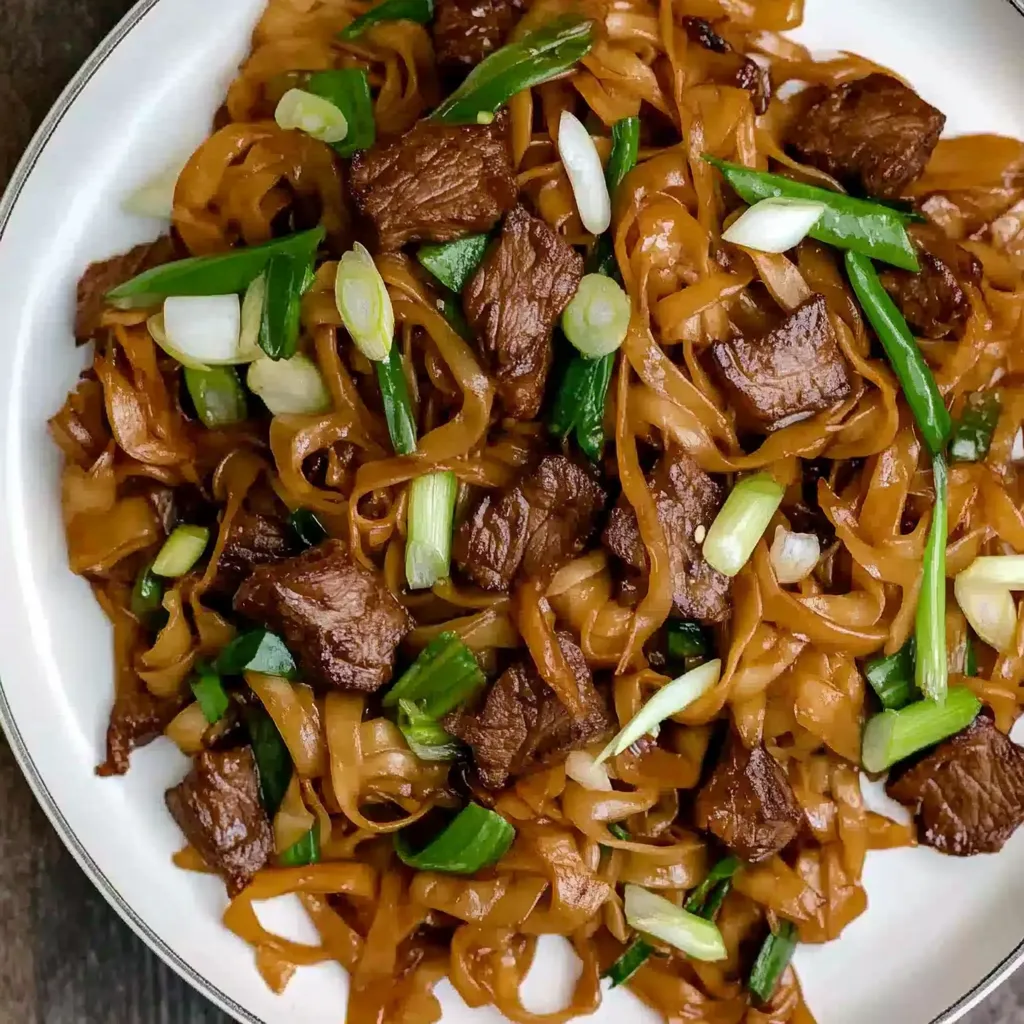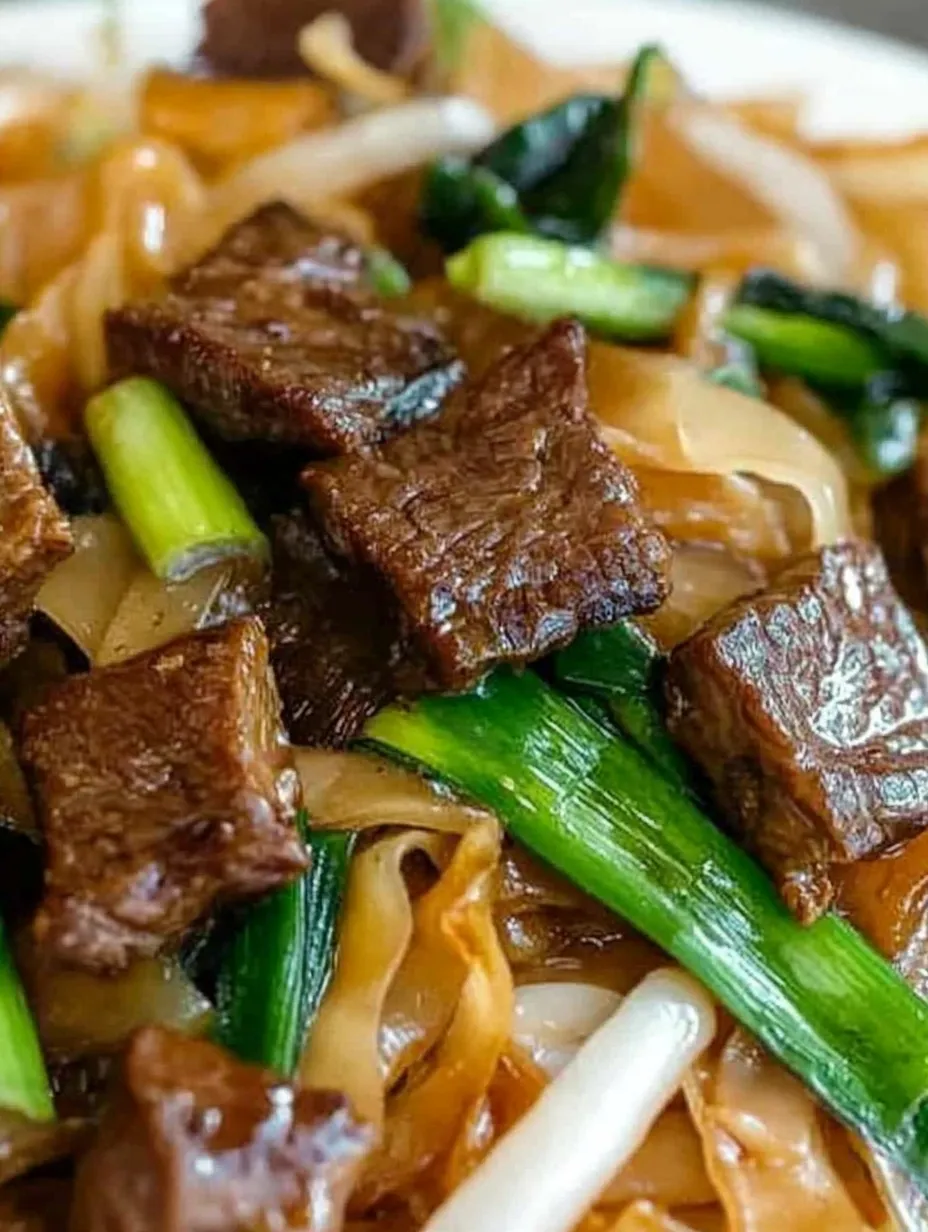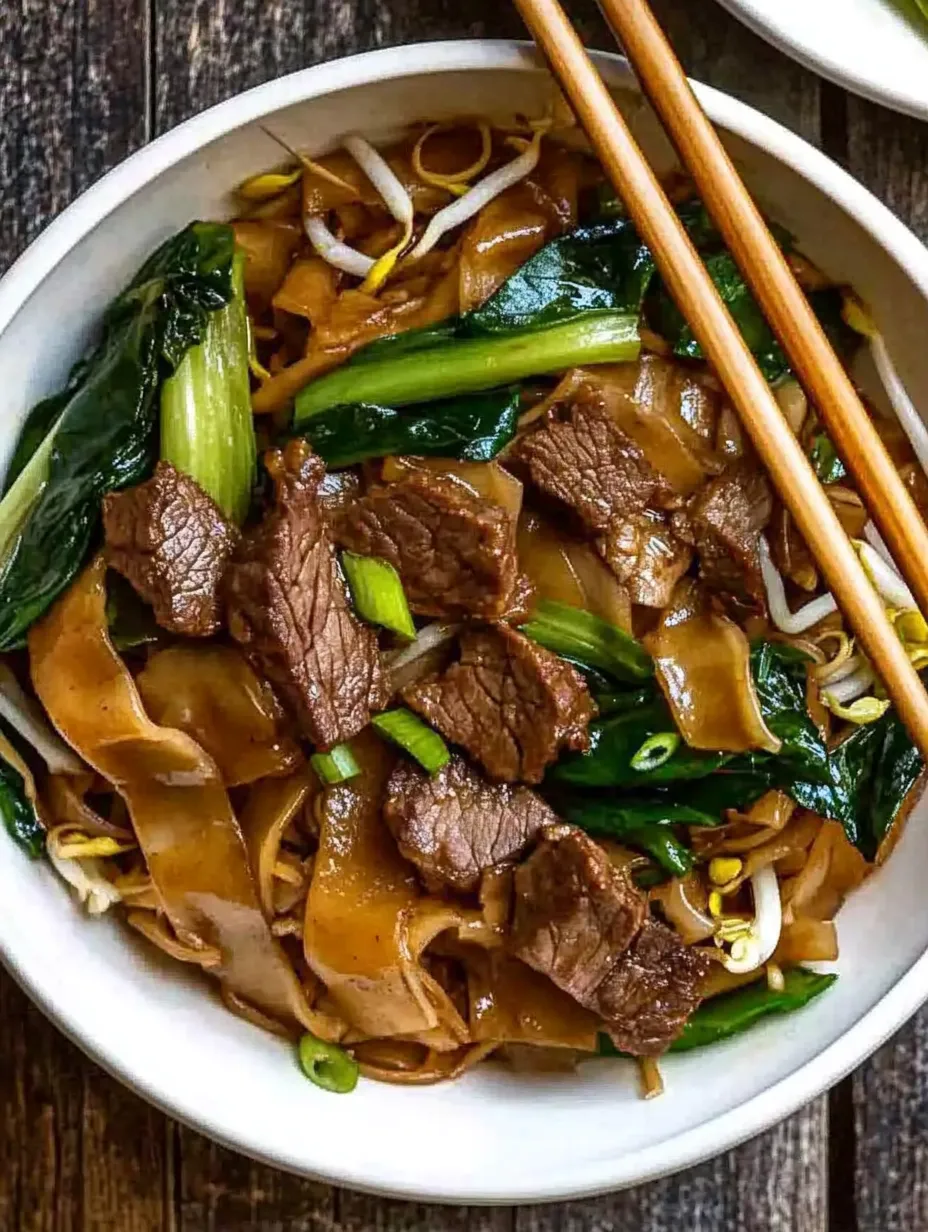 Pin it
Pin it
These silky rice noodles glisten with savory sauce as they cradle tender slices of beef and crisp vegetables in this Vietnamese street food classic that brings restaurant quality flavor to your home kitchen. The wide noodles develop delightful crispy edges while maintaining their signature chewy texture, creating a satisfying contrast in each forkful. This comforting dish balances complex umami flavors with bright vegetables and aromatic herbs that transport you straight to the bustling markets of Vietnam with minimal effort and maximum flavor.
I first discovered Hu Tieu Ap Chao at a tiny Vietnamese restaurant tucked away in a strip mall where the owner insisted I try her family recipe instead of my usual pho order. The first bite revealed why she was so proud of this dish the perfect balance of chewy noodles, tender beef, and that incredible savory sauce coating everything. It took several attempts at home to recreate those flavors, but this version consistently brings back the memory of that first experience. Now my family requests these noodles weekly, especially on cold evenings when we crave something both comforting and exciting.
Perfect Ingredient Selection
- Wide rice noodles: form the foundation of this dish with their distinct chewy texture that absorbs the savory sauce beautifully. Look for packages labeled "extra wide" or "chow fun" for the most authentic experience.
- Beef skirt steak: offers the ideal balance of tenderness and flavor for quick cooking. Its thin profile and rich marbling create succulent pieces that remain juicy after the high heat stir fry.
- Chinese broccoli: provides subtle bitterness that balances the rich sauce while adding vibrant color and nutrients. Its stems maintain pleasant crunch even after cooking, providing textural contrast.
- Dark soy sauce: contributes both deep color and complex flavor to the sauce unlike regular soy sauce. This ingredient creates the characteristic caramel hue that distinguishes authentic preparations.
- Oyster sauce: delivers essential umami richness that forms the backbone of the sauce, creating depth that cannot be achieved through other ingredients. Always choose premium brands for the best flavor.
Complete Cooking Process
- Prepare The Beef:
- Slice one pound of skirt steak against the grain into thin strips approximately two inches long and quarter inch thick. Place in a bowl and sprinkle with half teaspoon baking soda, one tablespoon soy sauce, one teaspoon sugar, and one tablespoon vegetable oil. Gently massage the marinade into the meat and let rest for fifteen minutes at room temperature. This brief marination with baking soda breaks down protein fibers, ensuring tender meat even with quick cooking, while the soy sauce and sugar begin flavor development that will complement the final sauce.
- Create The Sauce:
- In a small bowl, whisk together three tablespoons oyster sauce, two tablespoons soy sauce, one tablespoon dark soy sauce, one teaspoon sugar, and one teaspoon sesame oil until completely combined and sugar is dissolved. Add half teaspoon of sriracha if desired for gentle heat that complements without overwhelming the other flavors. This balanced sauce delivers the perfect combination of savory, sweet, and umami elements essential to authentic Hu Tieu Ap Chao.
- Prepare The Noodles:
- If using dried wide rice noodles, soak in warm water according to package directions until just pliable but not soft, usually about twenty minutes. For fresh or refrigerated noodles, separate them gently with your fingers to prevent clumping during cooking. The goal is partially hydrated noodles that will finish cooking in the wok, where they absorb the flavorful sauce while developing the signature crispy edges that distinguish restaurant quality preparations.
- Cook The Beef:
- Heat a wok or large skillet over high heat until smoking. Add two tablespoons of vegetable oil and immediately spread the marinated beef in a single layer. Allow it to sear undisturbed for one minute to develop caramelization before stirring briefly. Cook just until the meat loses its pink color, about two minutes total. Transfer to a clean plate, leaving any juices in the wok. This quick cooking preserves tenderness while developing flavor through Maillard reaction, creating complex notes that infuse the entire dish.
- Stir Fry The Vegetables:
- Return the wok to high heat and add another tablespoon of oil. Add one thinly sliced onion and cook for one minute until just beginning to soften. Add four cups chopped Chinese broccoli (stems and leaves separated) and cook the stems for one minute before adding the leaves. Stir fry for another minute until the leaves begin to wilt but remain vibrant green. The vegetables should maintain some crispness, providing textural contrast to the soft noodles and tender beef.
- Combine And Finish:
- Add the prepared noodles to the wok along with half of the sauce. Toss gently but thoroughly to coat the noodles with sauce and combine with vegetables. Spread the noodles across the surface of the wok and allow them to cook undisturbed for one minute to develop crispy edges. Gently turn sections of noodles and repeat. Return the beef and any accumulated juices to the wok along with two cups fresh bean sprouts and the remaining sauce. Toss everything together for one final minute until well combined and heated through. Garnish with sliced green onions and serve immediately.
 Pin it
Pin it
My family particularly enjoys the textural contrasts in this dish. My husband appreciates the caramelized edges of the noodles that develop during cooking, while my children love the tender beef pieces. I personally find the combination of crisp vegetables with the savory noodles most satisfying. We've established a tradition of serving this dish with additional sriracha and fresh herbs on the side, allowing everyone to customize their portion according to preference. The versatility of this recipe has made it our reliable choice when entertaining guests with different spice tolerances.
Delightful Serving Ideas
Serve these flavorful noodles family style on a large platter garnished with fresh herbs including cilantro, Thai basil, and mint for diners to add according to taste. Accompany with small dishes of traditional condiments such as sliced fresh chilis, lime wedges, and extra sriracha to customize heat levels. For a complete Vietnamese meal experience, start with fresh spring rolls as an appetizer and offer glasses of jasmine tea or coconut water alongside. The combination of crisp appetizers, satisfying noodles, and refreshing beverages creates a balanced dining experience reminiscent of authentic Vietnamese restaurants.
Creative Variation Options
Transform this versatile dish to match your preferences while maintaining its essential character. Substitute thinly sliced chicken thighs or peeled shrimp for the beef, adjusting cooking time accordingly to ensure proper doneness. Create a vegetarian version using firm tofu marinated in the same beef seasonings and crispy fried before adding to the noodles. For a more substantial vegetable presence, incorporate thinly sliced bell peppers, snow peas, or mushrooms along with the Chinese broccoli. Add a tablespoon of chili garlic sauce to the main sauce mixture for a spicier version that delivers consistent heat throughout the dish.
Practical Storage Solutions
Allow leftover noodles to cool completely before transferring to airtight containers and refrigerating for up to five days. The flavors actually develop further overnight, making this an excellent meal prep option. When reheating, add a tablespoon of water and cover loosely before microwaving to restore moisture, or reheat in a skillet with a touch of oil to revive some of the crispy texture. For longer storage, freeze in individual portions for up to three months. Thaw overnight in the refrigerator before reheating gently. The noodles may break more easily after freezing, but the flavor remains excellent.
 Pin it
Pin it
These Vietnamese flat rice noodles represent the beautiful fusion of cultures and flavors that makes Asian cuisine so compelling. The Chinese influence merges with distinctly Vietnamese elements to create something greater than the sum of its parts. What I love most about preparing this dish is how it transforms humble ingredients through specific techniques into something that feels special enough for celebrations yet remains accessible for everyday cooking. The balance of textures, colors, and flavors creates a multisensory experience that satisfies on every level while connecting us to culinary traditions that have evolved over generations.
Frequently Asked Questions
- → What type of rice noodles should I use for Vietnamese Flat Rice Noodles with Beef?
- For authentic Vietnamese Flat Rice Noodles with Beef (Hu Tieu Ap Chao), you want wide, flat rice noodles - the wider the better! They may be labeled as chow fun, hor fun, hu tieu, pad thai, or banh pho (wide version). You have three options: dried, refrigerated, or fresh. Refrigerated or fresh noodles are ideal as they're already soft and ready to stir-fry. If using dried noodles, boil them first until al dente (slightly undercooked), then rinse with cold water to stop the cooking process. If your refrigerated noodles are stiff and difficult to separate, cover them with a damp paper towel and microwave in 20-second intervals until softened enough to peel apart. This prevents them from breaking during cooking.
- → Why do you add baking soda to the beef in this recipe?
- Baking soda is the secret to achieving that signature tender, velvety texture you find in restaurant-style Asian beef dishes, including Vietnamese Flat Rice Noodles with Beef. It works as a tenderizer by raising the pH level on the meat's surface, making it difficult for proteins to bond tightly during cooking. This results in beef that stays tender instead of becoming tough, even with high-heat stir-frying. The small amount used (¼ teaspoon for ½ pound of beef) doesn't affect the flavor but makes a remarkable difference in texture. This technique is particularly valuable when using less expensive cuts like flank or skirt steak. Just be careful not to marinate for more than 20-25 minutes, as extended exposure can make the meat too soft and change its texture.
- → Can I make this dish vegetarian or vegan?
- Yes, Vietnamese Flat Rice Noodles can easily be made vegetarian or vegan! For a plant-based version, substitute the beef with either extra-firm tofu (pressed and cubed), tempeh, or seitan. You can also use sliced portobello mushrooms for a meaty texture. For the sauce, replace the oyster sauce with vegetarian oyster sauce (made from mushrooms) or hoisin sauce with a splash of mushroom soy sauce. Skip the baking soda since you won't need it for plant proteins. Add extra vegetables like sliced carrots, baby corn, or bok choy along with the Chinese broccoli for more variety and nutrition. The cooking process remains the same - just remember that tofu and plant-based proteins generally need less cooking time than beef. This vegan adaptation maintains all the delicious flavors and textures of the original dish!
- → What is Chinese broccoli (gai lan) and can I substitute it?
- Chinese broccoli (gai lan) is a leafy green vegetable with thick stems, flat dark green leaves, and sometimes small flower buds. It has a slightly bitter, earthy flavor similar to regular broccoli but with a more pronounced taste. If you can't find it for this Vietnamese Flat Rice Noodles dish, several alternatives work well: regular broccoli (cut into thin florets with stems sliced), broccolini (a hybrid of broccoli and gai lan), bok choy, yu choy, or even kale (remove thick stems). In a pinch, spinach can work too, though add it at the very end since it cooks much faster. Each substitute will change the flavor profile slightly, but all provide that necessary green vegetable component that balances the rich noodles and beef. Look for Chinese broccoli in Asian markets or in the international produce section of well-stocked grocery stores.
- → Why is my stir-fry soggy instead of having that restaurant-quality texture?
- Achieving restaurant-quality Vietnamese Flat Rice Noodles with beef comes down to several key factors. First, use a wok or large skillet that can handle high heat, and make sure it's properly preheated before adding ingredients. Cook in batches if needed - overcrowding the pan causes ingredients to steam rather than sear. Pat your vegetables dry before adding them, as excess moisture creates steam. For the noodles, make sure they're not overcooked before stir-frying - they should be slightly undercooked if using dried noodles. Another crucial tip is to keep everything moving quickly - the entire cooking process should take just minutes at high heat. Finally, make sure your sauce isn't too watery; it should cling to the noodles and create a glossy coating. If your sauce seems thin, mix ½ teaspoon cornstarch with 1 tablespoon water and stir it in at the end.
- → Can I prepare any components of this dish ahead of time?
- Vietnamese Flat Rice Noodles with Beef is perfect for partial prep ahead of time! Here's what you can do in advance: prepare the sauce and store it in an airtight container in the refrigerator for up to 3 days; slice the beef and marinate it for up to 8 hours (not longer, as the baking soda will over-tenderize); wash and cut all vegetables and store them in separate containers in the refrigerator for up to 2 days; and if using dried noodles, you can cook, rinse, and toss them with a little oil, then refrigerate for up to 2 days. When you're ready to cook, have everything lined up beside your wok or skillet, as the actual stir-frying happens very quickly. This approach turns a 45-minute recipe into a 15-minute meal on a busy weeknight while still maintaining all the fresh flavors and textures.
